中职英语第二册Book2(1-1)
- 格式:ppt
- 大小:253.50 KB
- 文档页数:13

中职英语第二册unit-12签发人:签发时间:年月日3签发人:签发时间:年月日4签发人:签发时间:年月日集体备课电子教案5签发人:签发时间:年月日讲授新课:Speaking: have a nice trip!Step one: words.Ask students to talk about the expressions in the box,make sure they know them.Which of the following preparation will you make before you start traveling? Tick your answeromittedStep two: listening.1. Ask students to read the information given, make sure theyunderstand them. Teacher may give some help wherenecessary if the students have any difficulties.train ticket booking office火车票售票处travel agency旅行社2. Ask students to listen to the dialogue, write down some keywords. Make sure they understand the dialogue and then circlethe best answer.Check the answer: a3. Ask students to read the questions, make sure theyunderstand them and know how to do and what to do.Listen again and tick the right answer.6签发人:签发时间:年月日集体备课电子教案7签发人:签发时间:年月日学法教学Computer手段教学程序与策略个性化修改一、复习导入:Some questions:Have you been to Disneyland? Do you like it?Step one: scanningAsk students to read through the passage, they should befamiliar with the passage and try to underline the difficulties.Ask students to read the passage as quickly as possible and then try to find the writer’s feeling about her trip to DisneylandKey: the writer accepted everything as a part of herexperience.Step two: skimmingAsk students to read the passage and try to tick true orfalse.Check up the answers.8签发人:签发时间:年月日江苏省中等专业学校集体备课电子教案9签发人:签发时间:年月日安排7 课时课题Unit 1 wordsand reading课型时间年月日教学目标1. read the passage2. language points教学设想重点1. master language points2. Reading comprehension. 难点language points教法学法practice and reading教签发人:签发时间:年月日10Divide the students into groups, Ask groups of students to read the passage paragraph by paragraph. pay attention to thereading skills.Ask individual student to read the passage one by one.They should read it fluently and smoothly.During reading, teacher may give some help if necessary.Step two: word studyAsk students to try to read the words by themselves, they may read each word carefully with referring to the phoneticsymbols.Ask the students to read the words after the teacher/tape, they should pay attention to the pronunciation and stress. Andthen ask them to read the words altogether. Correct theirmistakes if they have after reading the words.Ask individuals to read the words, they should read them correctly. Give them some help if they have while reading thewords.Step three: words and expressions1. arrive at/inat 后接较小的地点名词,如school, park.in后接较大的地点名词,如Beijing, Shanghai.11签发人:签发时间:年月日江苏省中等专业学校集体备课电子教案12签发人:签发时间:年月日教学设想难点Grammar and phonetics教法学法practice and reading教学手段Computer教学程序与策略个性化修改复习导入:Ask students to read the four vowels and words, makesure they know them and can read them correct签发人:签发时间:年月日131)ed 在清辅音[p][t][k][f][s][h]等后读[ t ],如:helped, washed, watched, marked, finished, stopped, skipped, cooked, worked2)ed 在浊辅音[d][g][v][z][r][m][n]等后及元音后读[d], 如:cleaned, played, prepared3)ed在[t][d]后读[id], 如:painted, started, visited2. ask the students to read the sentences, and they shouldknow how many times they hear the given vowel in eachsentence below, write the number in the brackets14签发人:签发时间:年月日Step two: grammar (exclamations感叹句)1.一、由what 引导的感叹句,其句子结构可分为以下三种:1.可用句型:“ What + a/an +形容词+可数名词单数+主语+谓语!”.如:What a nice present it is!它是一件多么好的礼物啊!What an interesting book it is!它是一本多么有趣的书啊!2.可用句型:“ What +形容词+可数名词复数+主语+谓语!”.如:What beautiful flowers they are!多么漂亮的花啊!What good children they are!他们是多么好的孩子啊!3.可用句型:“ What +形容词+不可数名词+主语+谓语!”.如:What fine weather it is today!今天天气多好啊!What important news it is!多重要的新闻啊!二、由how 引导的感叹句,其句子结构也分为三种:1.可用句型:“ How +形容词/ 副词+主语+谓语!”.如:How careful she is!她多么细心啊!How fast he runs!他跑得多快啊!2.可用句型:“ How +形容词+a/an +可数名词单数+主语+谓语!”. 如:How beautiful a girl she is! 她是个多么漂亮的姑娘啊!3.可用句型:“ How +主语+谓语!”.如:How time flies!光阴似箭!由what 引导的感叹句与由how 引导15签发人:签发时间:年月日What delicious cakes these are!=How delicious these cakes are!三、有时感叹句也可以由一个单词、词组、祈使句、陈述句等构成.如:Good idea!(好主意!)wonderful!(太精彩了!)Thank goodness!(谢天谢地!)2 Practice.Key: tick 1, 3,5,7,8.3. Finish the task. Check up the answers.Step three vocabulary1.Ask the students to read the words in the box, makesure they know the compass. And then finish the paragraphwith the directions..2.Ask the students to read the words in the box, and completethe sentences with the words from the box, change the form ifnecessary.Step four finish “the spring outing plan”Ask students to open the books and turn to page14, try tofinish the form. They can get help from the teacher if necessaryStep five homeworkRevise the words, phonetics, plan and the exclamations.16签发人:签发时间:年月日17签发人:签发时间:年月日。
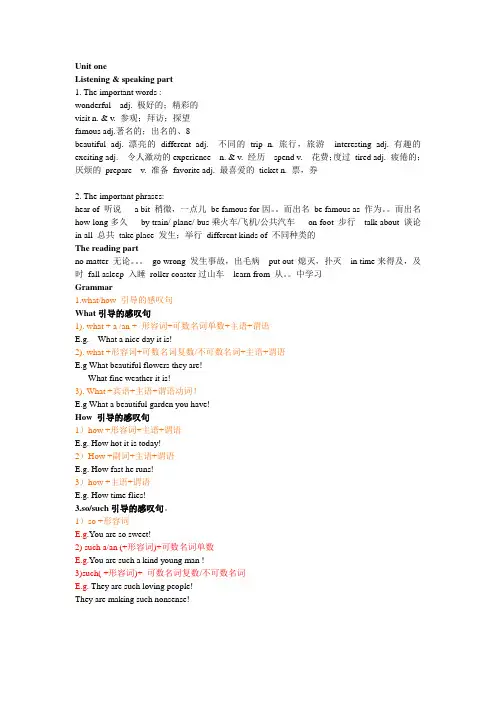
Unit oneListening & speaking part1. The important words :wonderful adj. 极好的;精彩的visit n. & v. 参观;拜访;探望famous adj.著名的;出名的、8beautiful adj. 漂亮的different adj. 不同的trip n. 旅行,旅游interesting adj. 有趣的exciting adj. 令人激动的experience n. & v. 经历spend v. 花费;度过tired adj. 疲倦的;厌烦的prepare v. 准备favorite adj. 最喜爱的ticket n. 票,券2. The important phrases:hear of 听说 a bit 稍微,一点儿be famous for因。
而出名be famous as 作为。
而出名how long多久by train/ plane/ bus乘火车/飞机/公共汽车on foot 步行talk about 谈论in all 总共take place 发生;举行different kinds of 不同种类的The reading partno matter 无论。
go wrong 发生事故,出毛病put out 熄灭,扑灭in time来得及,及时fall asleep 入睡roller coaster过山车learn from 从。
中学习Grammar1.what/how 引导的感叹句What引导的感叹句1). what + a /an + 形容词+可数名词单数+主语+谓语E.g. What a nice day it is!2). what +形容词+可数名词复数/不可数名词+主语+谓语E.g What beautiful flowers they are!What fine weather it is!3). What +宾语+主语+谓语动词!E.g What a beautiful garden you have!How 引导的感叹句1)how +形容词+主语+谓语E.g. How hot it is today!2)How +副词+主语+谓语E.g. How fast he runs!3)how +主语+谓语E.g. How time flies!3.so/such引导的感叹句。
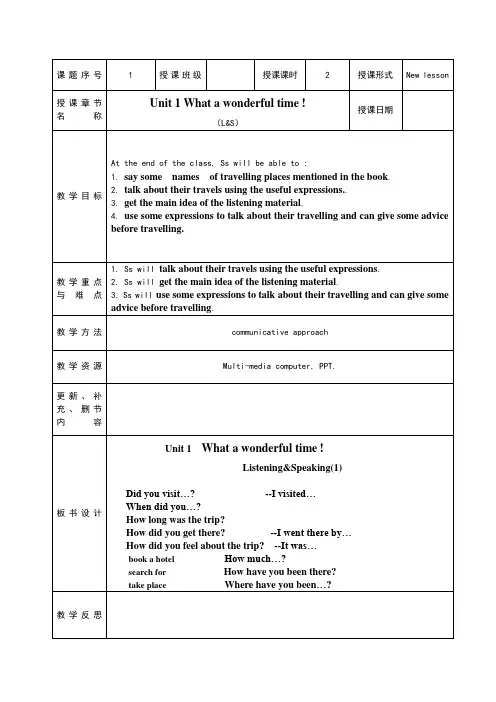
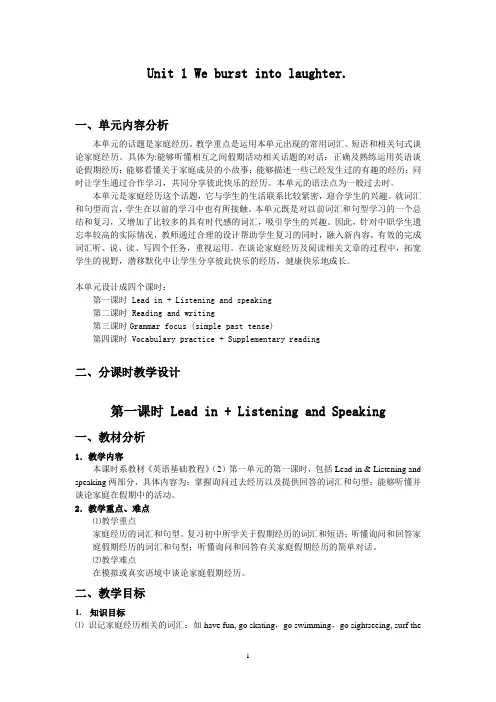
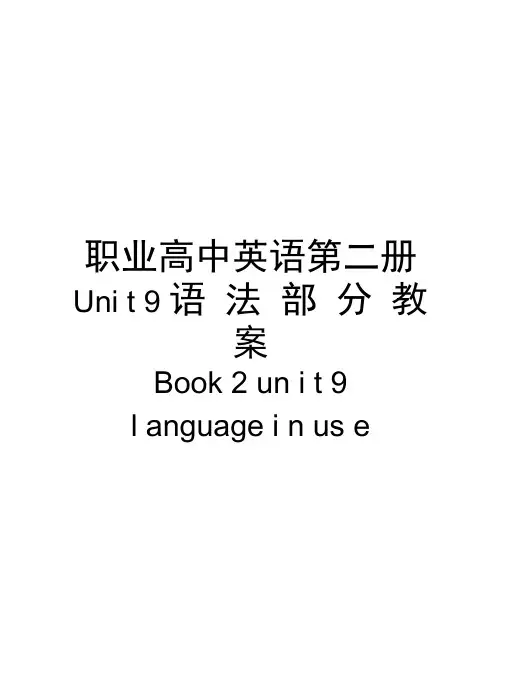
职业高中英语第二册Uni t 9 语法部分教案Book 2 un i t 9l anguage i n us e仅供学习与交流,如有侵权请联系网站删除谢谢2精品资料汨罗市职业中专学校教学方案设计(首页)精品资料汨罗市职业中专学校教学方案设计(正页)仅供学习与交流,如有侵权请联系网站删除谢谢3仅供学习与交流,如有侵权请联系网站删除谢谢4精品资料精品资料仅供学习与交流,如有侵权请联系网站删除谢谢5精品资料仅供学习与交流,如有侵权请联系网站删除谢谢6“主语+谓语+宾语”的句子转化成被动语态分为三步:将主动 语态的宾语变成主语,宾语如果为人称代词,则要使用主格形 式;将主动语态的谓语变成被动式 be +过去分词;主动语态 的主语变成被动语态句中by 的宾语,主语如果为人称代词, 转换后要使用宾格形式。
主格 宾格 所有格 宾格所有格 第一人称 I 、we me 、us my 、ourmine 、ours 第二人称 you youyouryours 第三人称单 she/he/ her / him her/hisher s hisit it its its 复数 they them their theirs Eg :People speak En glish in the World.主 谓宾f English __ is_spoken by_people in the World. 主 谓 by+宾语 They make shoes every day. 主 谓 宾f Shoes are made by them every day. 主 谓 by+宾语He gives us some suggesti ons.f We are give n some suggesti ons by him. She teaches me the song. f I am taught the song by her. I clea ned my bedroom last day.f My bedroom is clea ned by me last day. The whole World knows Ein ste in.f Ei nste in is known by the whole World. My mother cooks the meal at my home.f The meal is cooked by my mother at my home. 四、 •被动语态的否定形式:五、 被动语态的否定形式是在肯定句中的 be 动词后加not 构精品资料仅供学习与交流,如有侵权请联系网站删除谢谢7仅供学习与交流,如有侵权请联系网站删除谢谢8精品资料He was born in October ,1989 .精品资料仅供学习与交流,如有侵权请联系网站删除 谢谢9被动语态值得注意的事项:1. 我们之所以用被动语态是因为我们不清楚动作的执行者、或没有必要指出动词的执行者等。
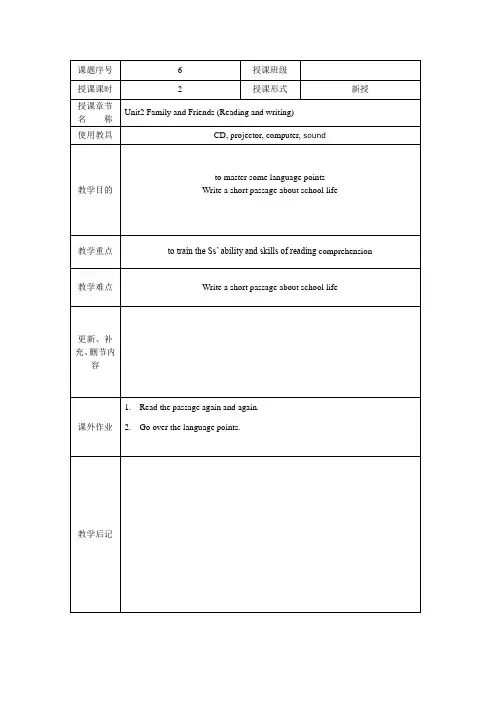
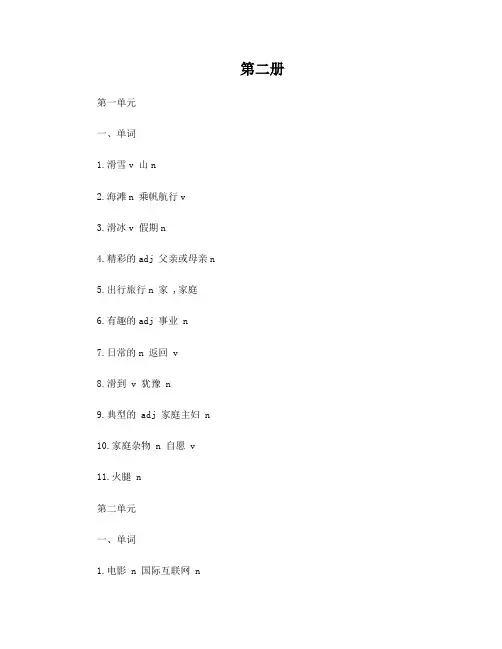
第二册第一单元一、单词1.滑雪v 山n2.海滩n 乘帆航行v3.滑冰v 假期n4.精彩的adj 父亲或母亲n5.出行旅行n 家 ,家庭6.有趣的adj 事业 n7.日常的n 返回 v8.滑到 v 犹豫 n9.典型的 adj 家庭主妇 n10.家庭杂物 n 自愿 v11.火腿 n第二单元一、单词1.电影 n 国际互联网 n2.体育馆 n 卡通片 n3.流行音乐勇敢的 adj4.伶俐的 adj 特别的 adj5.轻松的,放松的 adj. 动人的,感人的 adj6.爵士乐 n 动作电影7.恐怖电影喜剧 n8.脱口秀度过 n9.摇滚乐 n 乐队 n10.乡村音乐租用 v11.订购 v 更喜欢 v12.保持 v二、短语,句子1.你觉得电影咋样?2.在那时3.我邀请朋友一起看电影。
4.我一小时又一小时的坐在电脑前。
5.总是坐在一台机器前是浪费时间的。
6.你上周末做了什么特别的事吗?7.没什么特别的。
8.你以前喜欢什么类型的音乐?9.我曾喜欢爵士乐。
10.你过去喜欢什么类型的电影?11.我曾喜欢动作电影。
12.你通常是怎么过周末的?四.用动词的适当形式填空.cook, stay, say, tell, visit, come, think, take, be, eat1Last Sunday it was snowy. Maria 1 at home. Her cousin Cara 2 tovisit her. She came back from Beijing. She 3 Maria something about her vacation."It was pretty good," she said. Cara 4 the Palace Museum andthe Great Wall. She 5 a lot of photos.It was lunch time. Maria's parents 6 not at home. They decided to cook by themselves. Maria 7 noodles with some tomatoes and pepper (辣椒). After Cara 8 up the noodles, she said slowly, “I think it isdelicious!”But Maria 9 the food was too bad. She 10 ,“Cara, thank you, but I put too much pepper into it.第三单元一、单词1.有创造力的 adj 友好的,直爽的 adj2.自信的 adj 助手 n3.打字员 n 出纳员 n4.幼儿园 n 面试 n&v5.销售,经销 n 毕业 v6.交流 n 流利的 adj7.申请人 n 更有资格;更胜任 v8.张贴 v 广告,公告 n9.简历 n 尽早,尽快10.空闲时间 n 集体自由讨论 v二、短语,句子1.能介绍一下自己吗?2.我在一年公司兼职销售员两年了。

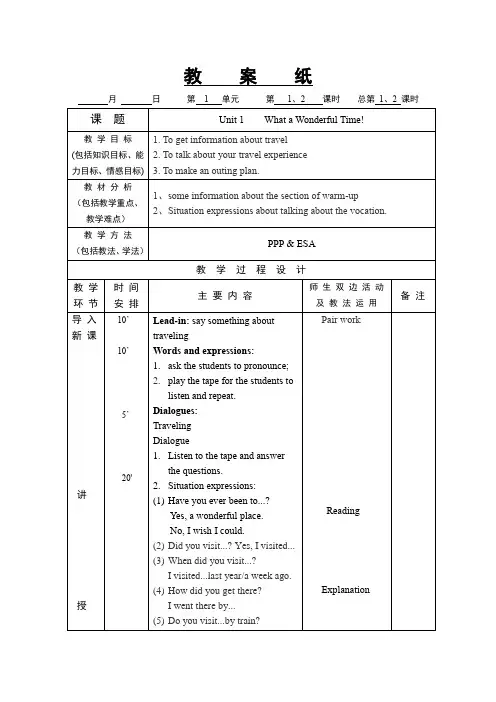
月日第 1 单元第1、2 课时总第1、2 课时(教学环节一般包括复习旧课、导入新课、讲授新课、学生操作、教师点评、归纳总结、布置作业等)月日第 1 单元第3、4 课时总第3、4 课时(教学环节一般包括复习旧课、导入新课、讲授新课、学生操作、教师点评、归纳总结、布置作业等月日第 1 单元第5、6 课时总第5、6 课时(教学环节一般包括复习旧课、导入新课、讲授新课、学生操作、教师点评、归纳总结、布置作业等)月日第 2 单元第1、2 课时总第7、8 课时(教学环节一般包括复习旧课、导入新课、讲授新课、学生操作、教师点评、归纳总结、布置作业等)月日第 2 单元第3、4 课时总第9、10 课时(教学环节一般包括复习旧课、导入新课、讲授新课、学生操作、教师点评、归纳总结、布置作业等月日第 2 单元第5、6 课时总第11、12 课时(教学环节一般包括复习旧课、导入新课、讲授新课、学生操作、教师点评、归纳总结、布置作业等)月日第 3 单元第1、2 课时总第13、14 课时(教学环节一般包括复习旧课、导入新课、讲授新课、学生操作、教师点评、归纳总结、布置作业等)月日第 3 单元第3、4 课时总第15、16 课时(教学环节一般包括复习旧课、导入新课、讲授新课、学生操作、教师点评、归纳总结、布置作业等月日第 3 单元第5、6 课时总第17、18 课时(教学环节一般包括复习旧课、导入新课、讲授新课、学生操作、教师点评、归纳总结、布置作业等)月日第 4 单元第1、2 课时总第19、20 课时(教学环节一般包括复习旧课、导入新课、讲授新课、学生操作、教师点评、归纳总结、布置作业等)教案纸月日第 4 单元第3、4 课时总第21、22 课时(教学环节一般包括复习旧课、导入新课、讲授新课、学生操作、教师点评、归纳总结、布置作业等教案纸月日第 4 单元第5、6 课时总第23、24 课时(教学环节一般包括复习旧课、导入新课、讲授新课、学生操作、教师点评、归纳总结、布置作业等)教案纸月日第 5 单元第1、2 课时总第25、26 课时(教学环节一般包括复习旧课、导入新课、讲授新课、学生操作、教师点评、归纳总结、布置作业等)教案纸月日第 5 单元第3、4 课时总第27、28 课时(教学环节一般包括复习旧课、导入新课、讲授新课、学生操作、教师点评、归纳总结、布置作业等教案纸月日第 5 单元第5、6 课时总第29、30 课时(教学环节一般包括复习旧课、导入新课、讲授新课、学生操作、教师点评、归纳总结、布置作业等)月日第 6 单元第1、2 课时总第31、32 课时(教学环节一般包括复习旧课、导入新课、讲授新课、学生操作、教师点评、归纳总结、布置作业等)月日第 6 单元第3、4 课时总第33、34 课时(教学环节一般包括复习旧课、导入新课、讲授新课、学生操作、教师点评、归纳总结、布置作业等月日第 6 单元第5、6 课时总第35、36 课时(教学环节一般包括复习旧课、导入新课、讲授新课、学生操作、教师点评、归纳总结、布置作业等)月日第7 单元第1、2 课时总第37、38 课时(教学环节一般包括复习旧课、导入新课、讲授新课、学生操作、教师点评、归纳总结、布置作业等)月日第7 单元第3、4 课时总第39、40 课时(教学环节一般包括复习旧课、导入新课、讲授新课、学生操作、教师点评、归纳总结、布置作业等月日第7 单元第5、6 课时总第41、42 课时(教学环节一般包括复习旧课、导入新课、讲授新课、学生操作、教师点评、归纳总结、布置作业等)月日第8 单元第1、2 课时总第43、44 课时(教学环节一般包括复习旧课、导入新课、讲授新课、学生操作、教师点评、归纳总结、布置作业等)月日第8 单元第3、4 课时总第45、46 课时(教学环节一般包括复习旧课、导入新课、讲授新课、学生操作、教师点评、归纳总结、布置作业等月日第8 单元第5、6 课时总第47、48 课时(教学环节一般包括复习旧课、导入新课、讲授新课、学生操作、教师点评、归纳总结、布置作业等)月日第9 单元第1、2 课时总第49、50 课时(教学环节一般包括复习旧课、导入新课、讲授新课、学生操作、教师点评、归纳总结、布置作业等)。


被动语态说课稿一、教材分析1.说教材的地位和作用被动语态是中职教材学习中的一个重点语法项目,同时也是高职考必考内容,其中情态动词的被动语态、各种时态的被动语态的结构及运用是教学中的一个难点和重点,因为被动语态可根据不同时态变换结构,因此,也是学生不容易理解和难以记忆的语法知识。
2.知识目标熟练掌握被动语态的概念,结构和基本用法。
掌握主动语态与被动语态的区别。
3.技能目标提高学生合作探究的能力。
培养学生对知识点归纳总结以及自主学习的能力。
4.情感目标培养学生团结互助精神。
增强学生学习学英语的自信心。
5.教学重难点重点:熟练掌握被动语态的概念,结构,用法。
难点:各种时态被动语态的运用。
二、学生情况分析学生们经过几年的学习已经接触了六种时态,由于被动语态结构变化较多,而且内容庞杂,学生不易理解和记忆,许多学生对那种“课堂上直接给出学生六种常见时态的被动语态结构,并要求学生熟练记忆,辅之以大量的机械性的变换练习”的授课方法完全不感兴趣,尽管有许多学生也努力记忆,但最终仍不能记住老师灌输的重要知识,因而产生畏惧和逃避心理,失去了学习兴趣。
本节课经过精心的设计,努力使学生在有趣、轻松的气氛中学会被动语态。
三、教学理念及教学策略选择与设计1.教学理念:根据美国社会语言学家海姆斯提出的交际教学法的观点,教师并不意味着“知识的传播者”,而应该是“学习的帮助者”。
在交际性教学活动中,学生应该是中心,但这并不意味着教师的作用弱化,这意味着教师的作用更加多元化,因而也更加重要。
Harmer把外语教师的角色定位为:控制者、评估者、组织者、提示者和参与者。
因为传统语法教学中存在诸多弊端,许多教师因而走向极端,对英语语法避而不讲,把主要精力放在听说上,学生询问其句子结构时,往往不从语法方面作任何解释,只是要求学生背住这些句子。
现代英语教学并不是要摒弃语法教学,只是需要改变语法课的授课方法,以使语法教学收到实效。
事实也证明,只要教师精心准备,语法课同样可以充满乐趣,激发起学生的学习兴趣、积极性和主动性。
江苏省中等专业学校集体备课电子教案江苏省中等专业学校集体备课电子教案江苏省中等专业学校集体备课电子教案江苏省中等专业学校集体备课电子教案江苏省中等专业学校集体备课电子教案教学目标1. Read the phonetics 2. grammar :questions and answers 3. V ocabulary 4. create an e-mail account教学设想重点1. master phonetics2. Create an e-mail account.难点Grammar and phonetics教法学法practice and reading教学手段Computer教学程序及策略特性化修改复习导入:Ask students to read the four vowels and words, make sure theyknow them and can read them correctStep one: phonetics study1. Ask students to try to read the words and phonetics bythemselves, they may read them carefully with referring to thephonetic symbols.Ask the students to read them after the teacher/tape, they shouldpay attention to the pronunciation. And then ask them to read thewords and phonetics altogether. Correct their mistakes if they haveafter reading the words and phonetics.Ask individuals to read the words and vowels, they should readthem correctly. Give them some help if they have while reading thewords.加ed 以后的发音有如下三种:1〕ed 在清辅音[p][t][k][f][s][h]等后读[ t ], 如:helped, washed, watched, marked, finished, stopped, skipped, cooked, worked2〕ed 在浊辅音[d][g][v][z][r][m][n]等后及元音后读[d], 如:cleaned, played, prepared3〕ed在[t][d]后读[id], 如:painted, started, visited。
浙江省中等职业学校课本《英语》第二册(浙江人民出版社出版)Unit 3 In the citiesPeriod 1 Lesson Nine乐清市职业中等专业学校陈珍珍Teaching aims:1. Direct the students to understand and master the following words and phrases:subway, amusement, gymnasium, rhythm, brand-new, self-service restaurant;2. Learn the incomplete plosive;3. Improve the students’ listening ability;4. Enjoy the song Rhythm of the Rain.Teaching important points:Train the student s’ listening ability.Teaching difficult points:1.Master the uncompleted plosive;2.Help the students improve their listening memory ability.Teaching methods:Listening and cooperative learning.Teaching aids:CAITeaching procedures:Step 1 Lead-inIt’s spring now. It’s a good time for us to travel. I’ll go to a beautiful city to spend my weekend. Can you guess where it is?Give the Ss three clues:It’s in the east of China.It’s a busy city.It’s the biggest city in our country.Guide them to ask with the sentence “Is it …?”. It’s Shanghai. (Show the picture of shanghai.)Ask the Ss to give me some advice on how to go to Shanghai. Guide them to use the sentence “You’d better go there by….”.I’ll go there by train because it’s cheap and comfortable.Now I’m at the railway station. I want to go to the Jinjiang Park. It’s an amusement park. How can I get there in a most convenient way?Shanghai is a busy city. I t’s always very crowded. So I’d better go there by subway.Step 2 Warm-upThere are many people and many different places in Shanghai and some other cities. Look at the following pictures. Where are these places? Match the pictures with the names.subway gymnasium hospital police station______ ______ ______ ______Supermarket restaurant cinema amusement park______ ______ ______ ______Step 3 Listen and imitateIntroduce what the plosive is.Show the following:爆破音有清浊三对,每对的发音部位相同,它们是:清浊/p/ /b//t/ /d//k/ /g/不完全爆破是指第一个爆破音不发生爆破,而只是由有关的发音器官形成阻碍,这时它的口腔部位和原爆破音相同,停顿而不送气。